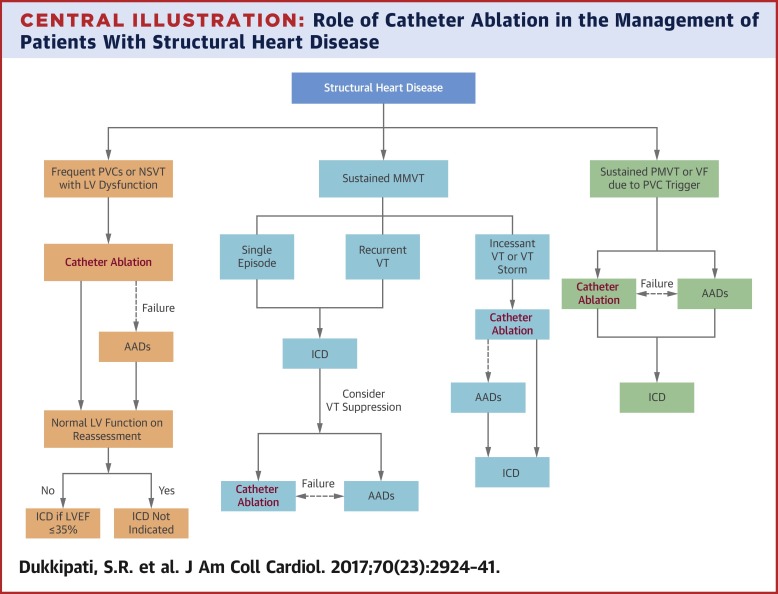当前位置:
X-MOL 学术
›
J. Am. Coll. Cardiol.
›
论文详情
Our official English website, www.x-mol.net, welcomes your feedback! (Note: you will need to create a separate account there.)
Catheter Ablation of Ventricular Tachycardia in Structural Heart Disease
Journal of the American College of Cardiology ( IF 24.0 ) Pub Date : 2017-12-01 , DOI: 10.1016/j.jacc.2017.10.030 Srinivas R. Dukkipati , Jacob S. Koruth , Subbarao Choudry , Marc A. Miller , William Whang , Vivek Y. Reddy
Journal of the American College of Cardiology ( IF 24.0 ) Pub Date : 2017-12-01 , DOI: 10.1016/j.jacc.2017.10.030 Srinivas R. Dukkipati , Jacob S. Koruth , Subbarao Choudry , Marc A. Miller , William Whang , Vivek Y. Reddy

|
In contrast to ventricular tachycardia (VT) that occurs in the setting of a structurally normal heart, VT that occurs in patients with structural heart disease carries an elevated risk for sudden cardiac death (SCD), and implantable cardioverter-defibrillators (ICDs) are the mainstay of therapy. In these individuals, catheter ablation may be used as adjunctive therapy to treat or prevent repetitive ICD therapies when antiarrhythmic drugs are ineffective or not desired. However, certain patients with frequent premature ventricular contractions (PVCs) or VT and tachycardiomyopathy should be considered for ablation before ICD implantation because left ventricular function may improve, consequently decreasing the risk of SCD and obviating the need for an ICD. The goal of this paper is to review the pathophysiology, mechanism, and management of VT in the setting of structural heart disease and discuss the evolving role of catheter ablation in decreasing ventricular arrhythmia recurrence.
中文翻译:

结构性心脏病室性心动过速的导管消融术
与发生在结构正常心脏情况下的室性心动过速 (VT) 相比,发生在结构性心脏病患者中的 VT 会增加心源性猝死 (SCD) 的风险,而植入式心律转复除颤器 (ICD) 是治疗的中流砥柱。在这些个体中,当抗心律失常药物无效或不需要时,导管消融可用作辅助治疗以治疗或预防重复性 ICD 治疗。然而,某些频繁发生室性早搏 (PVC) 或 VT 和心动过速的患者应在 ICD 植入前考虑消融,因为左心室功能可能会改善,从而降低 SCD 的风险并避免对 ICD 的需要。本文的目的是回顾病理生理学、机制、
更新日期:2017-12-01
中文翻译:

结构性心脏病室性心动过速的导管消融术
与发生在结构正常心脏情况下的室性心动过速 (VT) 相比,发生在结构性心脏病患者中的 VT 会增加心源性猝死 (SCD) 的风险,而植入式心律转复除颤器 (ICD) 是治疗的中流砥柱。在这些个体中,当抗心律失常药物无效或不需要时,导管消融可用作辅助治疗以治疗或预防重复性 ICD 治疗。然而,某些频繁发生室性早搏 (PVC) 或 VT 和心动过速的患者应在 ICD 植入前考虑消融,因为左心室功能可能会改善,从而降低 SCD 的风险并避免对 ICD 的需要。本文的目的是回顾病理生理学、机制、



























 京公网安备 11010802027423号
京公网安备 11010802027423号